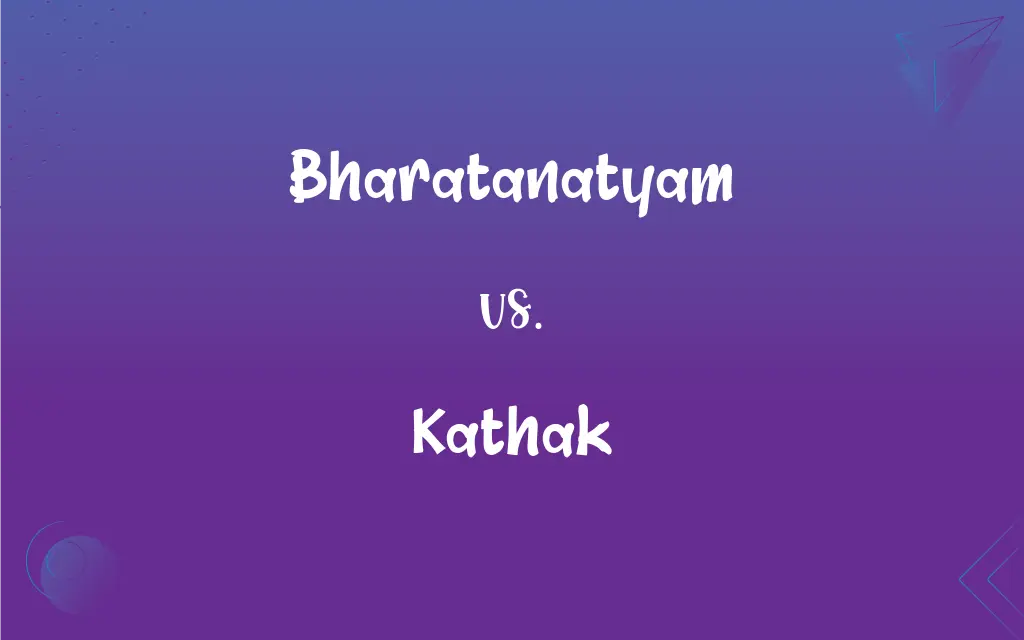Bharatanatyam vs. Kathak: What's the Difference?
Edited by Aimie Carlson || By Janet White || Published on March 29, 2024
Bharatanatyam, from South India, emphasizes fixed upper torso, bent legs, and a combination of hand gestures and footwork, symbolizing fire; Kathak, from North India, focuses on storytelling through fluid movements and fast footwork.

Key Differences
Bharatanatyam has its roots in the temples of Tamil Nadu, South India, reflecting the region's religious and cultural traditions. Kathak, in contrast, evolved in Northern India, with influences from both Hindu and Muslim cultures.
Bharatanatyam is known for its precise, geometric movements, and statuesque poses, emphasizing angularity and strong lines. Kathak, on the other hand, is characterized by more fluid, graceful movements, and whirls, focusing on storytelling through intricate footwork and facial expressions.
Bharatanatyam's rhythm is marked by intricate footwork and the use of hand gestures (mudras) to tell stories. Kathak places a greater emphasis on complex footwork synchronized with the rhythm, using ghungroos to accentuate the beats.
Bharatanatyam dancers wear a tailored costume with pleated material that opens out into a fan when the dancer bends her knees, along with traditional jewelry. Kathak costumes vary with gender; women typically wear a long, flowing skirt (lehenga) and men a kurta-churidar, with minimal jewelry compared to Bharatanatyam.
Bharatanatyam is performed to Carnatic music and often includes vocal accompaniment. Kathak is typically set to Hindustani music, with a strong emphasis on the rhythm (tabla or pakhawaj) guiding the dance.
ADVERTISEMENT
Comparison Chart
Origin
Tamil Nadu, South India
North India
Movement Style
Precise, geometric, statuesque
Fluid, graceful, whirls
Rhythmic Focus
Footwork, hand gestures
Complex footwork, ankle bells
Costume
Tailored costume, traditional jewelry
Lehenga or kurta, minimal jewelry
Music
Carnatic music, vocal accompaniment
Hindustani music, rhythm emphasis
ADVERTISEMENT
Bharatanatyam and Kathak Definitions
Bharatanatyam
Classical Dance Form.
Bharatanatyam is a renowned classical dance form from South India.
Kathak
North Indian Dance.
Kathak is a classical dance form originating from North India.
Bharatanatyam
Temple Dance Tradition.
Bharatanatyam was historically performed in temples.
Kathak
Fluid Movements.
Kathak is known for its fluid and dynamic movements.
Bharatanatyam
Rhythmic Footwork.
The rhythmic footwork in Bharatanatyam is intricate and precise.
Kathak
Use of Ghungroos.
The use of ghungroos in Kathak enhances the rhythmic footwork.
Bharatanatyam
Mudra Usage.
In Bharatanatyam, mudras are key to conveying the story.
Kathak
Storytelling Through Dance.
Kathak uniquely tells stories through dance movements.
Bharatanatyam
Cultural Expression.
Bharatanatyam is a profound expression of South Indian culture.
Kathak
Cultural Synthesis.
Kathak represents a cultural synthesis, blending Hindu and Muslim influences.
Kathak
One of the eight classical dance forms of India.
FAQs
Is Bharatanatyam a solo dance?
Traditionally, yes, it's performed as a solo dance form.
What is Bharatanatyam known for?
Its precise, geometric movements and spiritual expression.
What is a distinctive feature of Kathak?
Its fluid movements and rapid, intricate footwork.
Can Kathak be performed in groups?
Yes, Kathak can be performed solo or in groups.
How old is the Bharatanatyam tradition?
It dates back to ancient times, over 2000 years old.
What do Kathak dancers wear?
Women wear a lehenga, and men wear a kurta-churidar.
What is the meaning of 'Bharatanatyam'?
The name is derived from Bhava (expression), Raga (music), Tala (rhythm), and Natyam (dance).
What role do ghungroos play in Kathak?
Ghungroos accentuate the rhythmic footwork and beats.
Are mudras important in Bharatanatyam?
Yes, mudras (hand gestures) are crucial for storytelling.
Is Kathak easy to learn?
It requires dedication and practice, like any classical dance.
How long does it take to master Kathak?
Mastery can take years of dedicated practice.
Are there different styles within Bharatanatyam?
Yes, there are different styles or 'bani' within Bharatanatyam.
What is a Kathak performance like?
It's dynamic and expressive, often telling a story or depicting emotions.
Can Bharatanatyam be performed to modern music?
While traditional music is common, modern compositions are also used.
What musical instruments accompany Kathak?
Typically, tabla or pakhawaj for rhythm, and other Hindustani classical instruments.
Is Bharatanatyam only a religious dance?
It originated in temples but has evolved to include non-religious themes.
What's the training like for Bharatanatyam?
It involves rigorous training in dance technique and expression.
Does Kathak involve vocal music?
It can, but the focus is more on the rhythm and dance.
Can anyone learn Bharatanatyam?
Yes, it's open to anyone interested in learning.
Is improvisation a part of Kathak?
Yes, improvisation is an integral part of Kathak performances.
About Author
Written by
Janet WhiteJanet White has been an esteemed writer and blogger for Difference Wiki. Holding a Master's degree in Science and Medical Journalism from the prestigious Boston University, she has consistently demonstrated her expertise and passion for her field. When she's not immersed in her work, Janet relishes her time exercising, delving into a good book, and cherishing moments with friends and family.
Edited by
Aimie CarlsonAimie Carlson, holding a master's degree in English literature, is a fervent English language enthusiast. She lends her writing talents to Difference Wiki, a prominent website that specializes in comparisons, offering readers insightful analyses that both captivate and inform.
































































